ignition CADILLAC ESCALADE ESV 2008 Owners Manual
[x] Cancel search | Manufacturer: CADILLAC, Model Year: 2008, Model line: ESCALADE ESV, Model: CADILLAC ESCALADE ESV 2008Pages: 500, PDF Size: 6.65 MB
Page 8 of 500
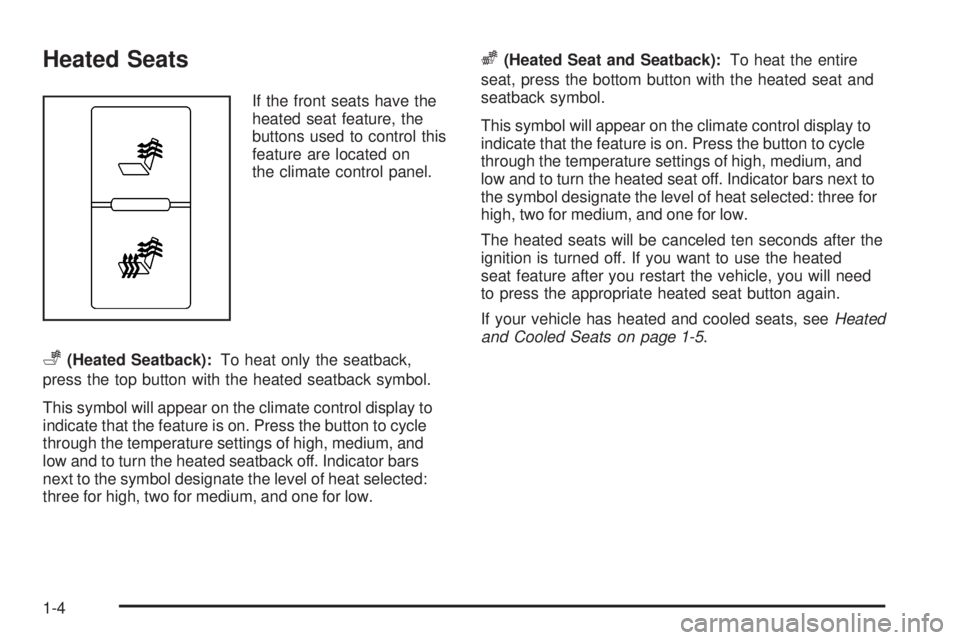
Heated Seats If the front seats have the
heated seat feature, the
buttons used to control this
feature are located on
the climate control panel.
+ (Heated Seatback): To heat only the seatback,
press the top button with the heated seatback symbol.
This symbol will appear on the climate control display to
indicate that the feature is on. Press the button to cycle
through the temperature settings of high, medium, and
low and to turn the heated seatback off. Indicator bars
next to the symbol designate the level of heat selected:
three for high, two for medium, and one for low. z (Heated Seat and Seatback): To heat the entire
seat, press the bottom button with the heated seat and
seatback symbol.
This symbol will appear on the climate control display to
indicate that the feature is on. Press the button to cycle
through the temperature settings of high, medium, and
low and to turn the heated seat off. Indicator bars next to
the symbol designate the level of heat selected: three for
high, two for medium, and one for low.
The heated seats will be canceled ten seconds after the
ignition is turned off. If you want to use the heated
seat feature after you restart the vehicle, you will need
to press the appropriate heated seat button again.
If your vehicle has heated and cooled seats, see Heated
and Cooled Seats on page 1-5 .
1-4
Page 9 of 500
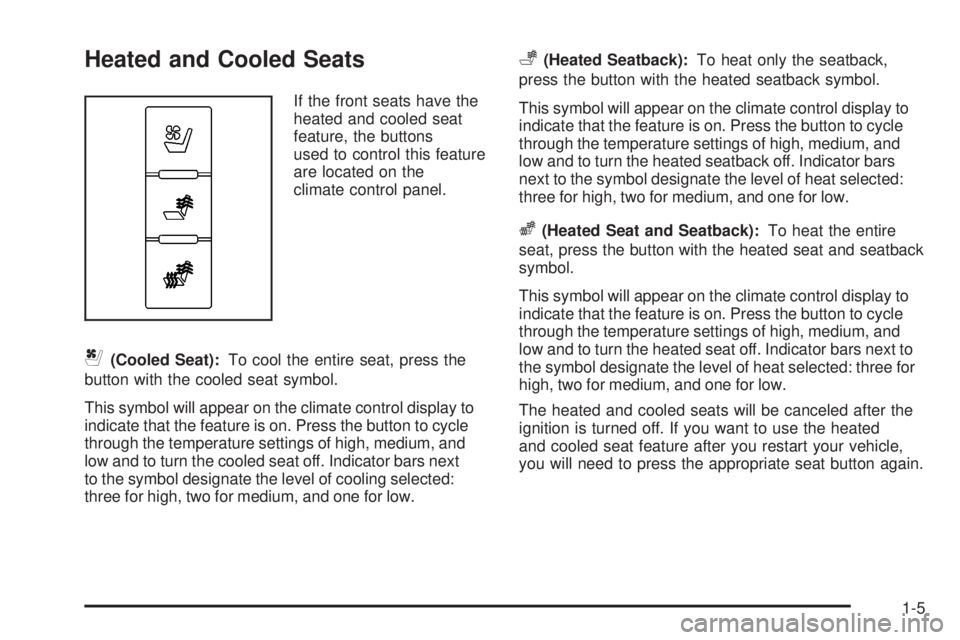
Heated and Cooled Seats If the front seats have the
heated and cooled seat
feature, the buttons
used to control this feature
are located on the
climate control panel.
{ (Cooled Seat): To cool the entire seat, press the
button with the cooled seat symbol.
This symbol will appear on the climate control display to
indicate that the feature is on. Press the button to cycle
through the temperature settings of high, medium, and
low and to turn the cooled seat off. Indicator bars next
to the symbol designate the level of cooling selected:
three for high, two for medium, and one for low. + (Heated Seatback): To heat only the seatback,
press the button with the heated seatback symbol.
This symbol will appear on the climate control display to
indicate that the feature is on. Press the button to cycle
through the temperature settings of high, medium, and
low and to turn the heated seatback off. Indicator bars
next to the symbol designate the level of heat selected:
three for high, two for medium, and one for low.
z (Heated Seat and Seatback): To heat the entire
seat, press the button with the heated seat and seatback
symbol.
This symbol will appear on the climate control display to
indicate that the feature is on. Press the button to cycle
through the temperature settings of high, medium, and
low and to turn the heated seat off. Indicator bars next to
the symbol designate the level of heat selected: three for
high, two for medium, and one for low.
The heated and cooled seats will be canceled after the
ignition is turned off. If you want to use the heated
and cooled seat feature after you restart your vehicle,
you will need to press the appropriate seat button again.
1-5
Page 11 of 500
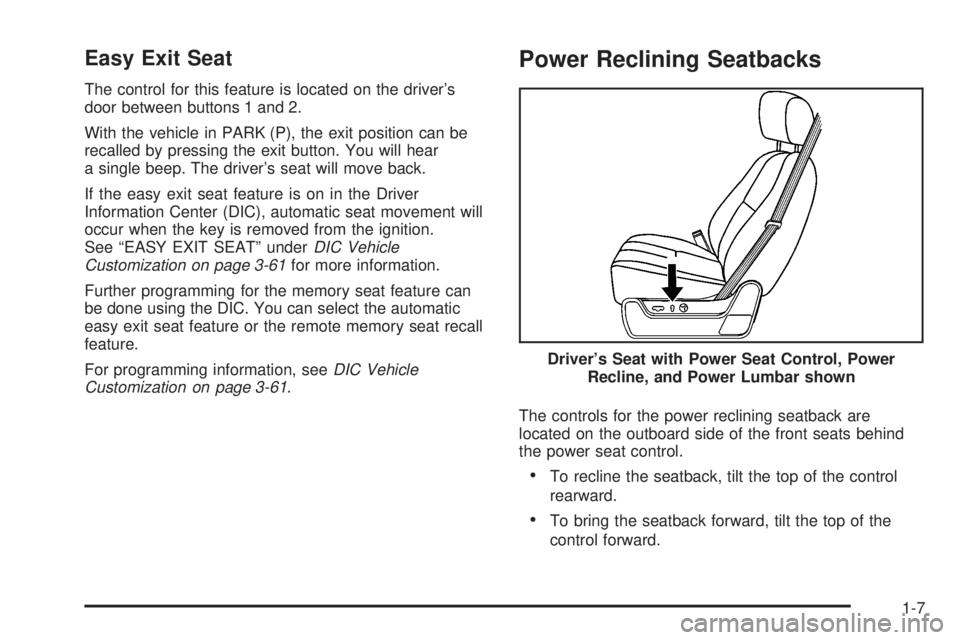
Easy Exit Seat The control for this feature is located on the driver’s
door between buttons 1 and 2.
With the vehicle in PARK (P), the exit position can be
recalled by pressing the exit button. You will hear
a single beep. The driver’s seat will move back.
If the easy exit seat feature is on in the Driver
Information Center (DIC), automatic seat movement will
occur when the key is removed from the ignition.
See “EASY EXIT SEAT” under DIC Vehicle
Customization on page 3-61 for more information.
Further programming for the memory seat feature can
be done using the DIC. You can select the automatic
easy exit seat feature or the remote memory seat recall
feature.
For programming information, see DIC Vehicle
Customization on page 3-61 . Power Reclining Seatbacks
The controls for the power reclining seatback are
located on the outboard side of the front seats behind
the power seat control.
To recline the seatback, tilt the top of the control
rearward.
To bring the seatback forward, tilt the top of the
control forward.Driver’s Seat with Power Seat Control, Power
Recline, and Power Lumbar shown
1-7
Page 14 of 500
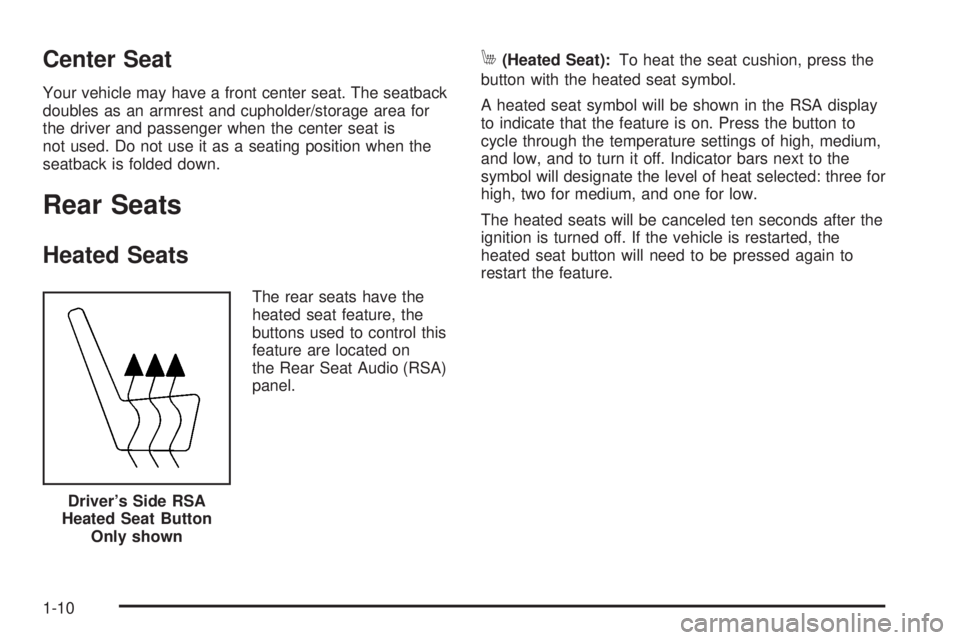
Center Seat Your vehicle may have a front center seat. The seatback
doubles as an armrest and cupholder/storage area for
the driver and passenger when the center seat is
not used. Do not use it as a seating position when the
seatback is folded down.
Rear Seats Heated Seats The rear seats have the
heated seat feature, the
buttons used to control this
feature are located on
the Rear Seat Audio (RSA)
panel. M (Heated Seat): To heat the seat cushion, press the
button with the heated seat symbol.
A heated seat symbol will be shown in the RSA display
to indicate that the feature is on. Press the button to
cycle through the temperature settings of high, medium,
and low, and to turn it off. Indicator bars next to the
symbol will designate the level of heat selected: three for
high, two for medium, and one for low.
The heated seats will be canceled ten seconds after the
ignition is turned off. If the vehicle is restarted, the
heated seat button will need to be pressed again to
restart the feature.
Driver’s Side RSA
Heated Seat Button
Only shown
1-10
Page 94 of 500
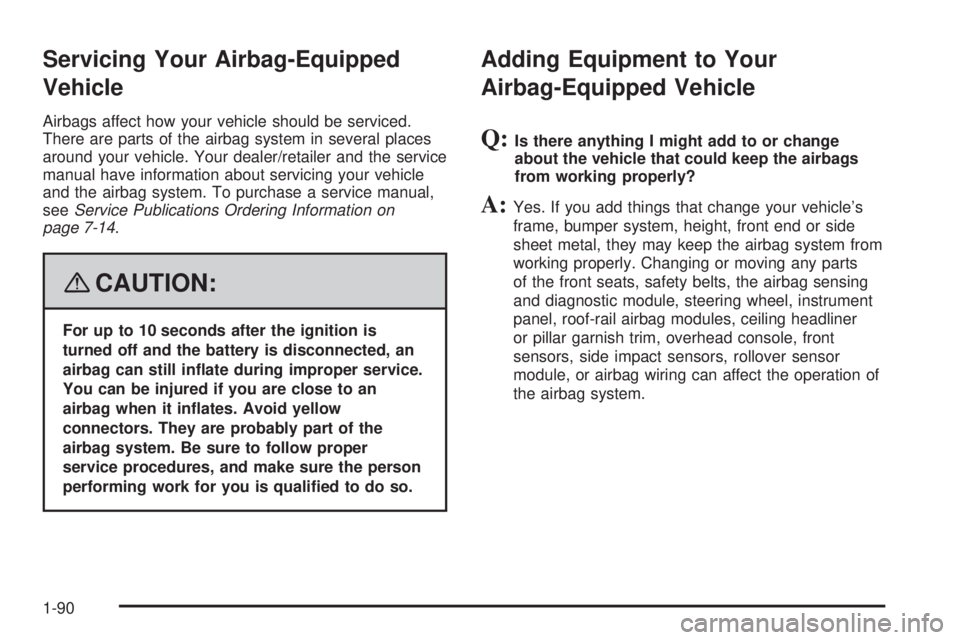
Servicing Your Airbag-Equipped
Vehicle Airbags affect how your vehicle should be serviced.
There are parts of the airbag system in several places
around your vehicle. Your dealer/retailer and the service
manual have information about servicing your vehicle
and the airbag system. To purchase a service manual,
see Service Publications Ordering Information on
page 7-14 .
{ CAUTION: For up to 10 seconds after the ignition is
turned off and the battery is disconnected, an
airbag can still in�ate during improper service.
You can be injured if you are close to an
airbag when it in�ates. Avoid yellow
connectors. They are probably part of the
airbag system. Be sure to follow proper
service procedures, and make sure the person
performing work for you is quali�ed to do so. Adding Equipment to Your
Airbag-Equipped Vehicle
Q: Is there anything I might add to or change
about the vehicle that could keep the airbags
from working properly?
A: Yes. If you add things that change your vehicle’s
frame, bumper system, height, front end or side
sheet metal, they may keep the airbag system from
working properly. Changing or moving any parts
of the front seats, safety belts, the airbag sensing
and diagnostic module, steering wheel, instrument
panel, roof-rail airbag modules, ceiling headliner
or pillar garnish trim, overhead console, front
sensors, side impact sensors, rollover sensor
module, or airbag wiring can affect the operation of
the airbag system.
1-90
Page 99 of 500
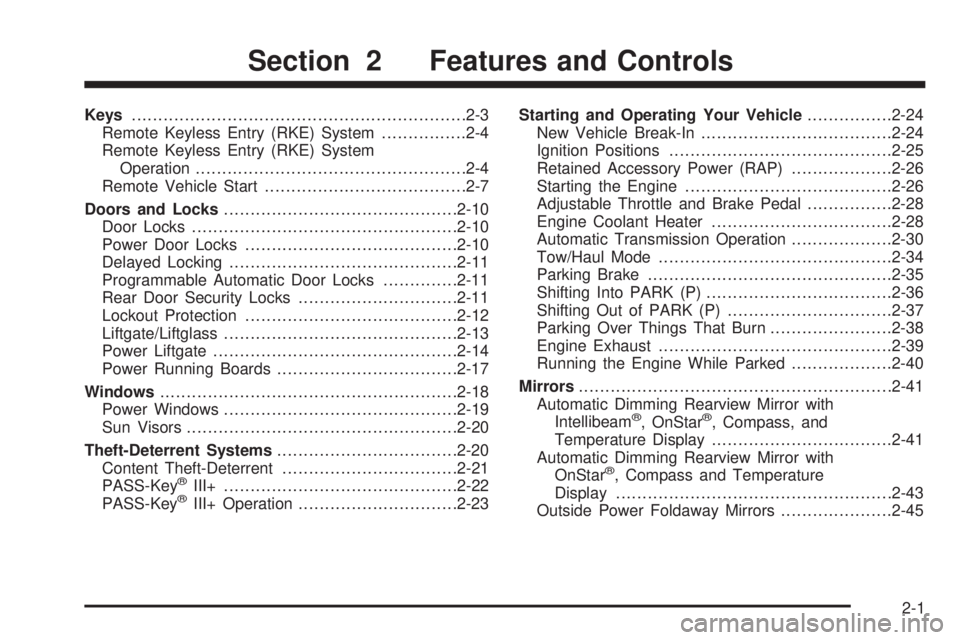
Keys .............................................................. .2-3
Remote Keyless Entry (RKE) System ............... .2-4
Remote Keyless Entry (RKE) System
Operation .................................................. .2-4
Remote Vehicle Start ..................................... .2-7
Doors and Locks ........................................... .2-10
Door Locks ................................................. .2-10
Power Door Locks ....................................... .2-10
Delayed Locking .......................................... .2-11
Programmable Automatic Door Locks ............. .2-11
Rear Door Security Locks ............................. .2-11
Lockout Protection ....................................... .2-12
Liftgate/Liftglass ........................................... .2-13
Power Liftgate ............................................. .2-14
Power Running Boards ................................. .2-17
Windows ....................................................... .2-18
Power Windows ........................................... .2-19
Sun Visors .................................................. .2-20
Theft-Deterrent Systems ................................. .2-20
Content Theft-Deterrent ................................ .2-21
PASS-Key ®
III+ ........................................... .2-22
PASS-Key ®
III+ Operation ............................. .2-23 Starting and Operating Your Vehicle ............... .2-24
New Vehicle Break-In ................................... .2-24
Ignition Positions ......................................... .2-25
Retained Accessory Power (RAP) .................. .2-26
Starting the Engine ...................................... .2-26
Adjustable Throttle and Brake Pedal ............... .2-28
Engine Coolant Heater ................................. .2-28
Automatic Transmission Operation .................. .2-30
Tow/Haul Mode ........................................... .2-34
Parking Brake ............................................. .2-35
Shifting Into PARK (P) .................................. .2-36
Shifting Out of PARK (P) .............................. .2-37
Parking Over Things That Burn ...................... .2-38
Engine Exhaust ........................................... .2-39
Running the Engine While Parked .................. .2-40
Mirrors .......................................................... .2-41
Automatic Dimming Rearview Mirror with
Intellibeam ®
, OnStar ®
, Compass, and
Temperature Display ................................. .2-41
Automatic Dimming Rearview Mirror with
OnStar ®
, Compass and Temperature
Display ................................................... .2-43
Outside Power Foldaway Mirrors .................... .2-45Section 2 Features and Controls
2-1
Page 101 of 500
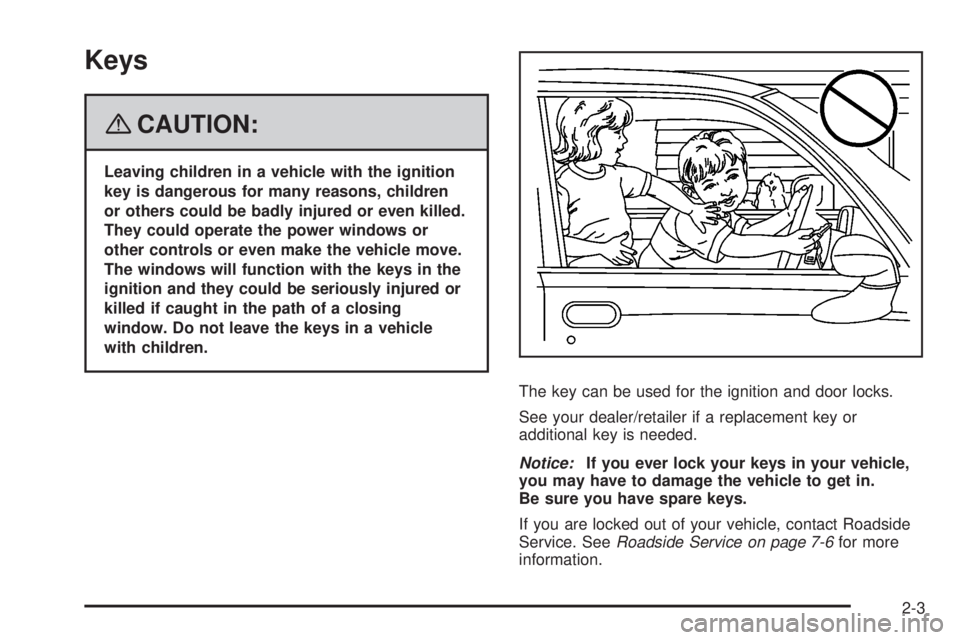
Keys
{ CAUTION: Leaving children in a vehicle with the ignition
key is dangerous for many reasons, children
or others could be badly injured or even killed.
They could operate the power windows or
other controls or even make the vehicle move.
The windows will function with the keys in the
ignition and they could be seriously injured or
killed if caught in the path of a closing
window. Do not leave the keys in a vehicle
with children.
The key can be used for the ignition and door locks.
See your dealer/retailer if a replacement key or
additional key is needed.
Notice: If you ever lock your keys in your vehicle,
you may have to damage the vehicle to get in.
Be sure you have spare keys.
If you are locked out of your vehicle, contact Roadside
Service. See Roadside Service on page 7-6 for more
information.
2-3
Page 103 of 500
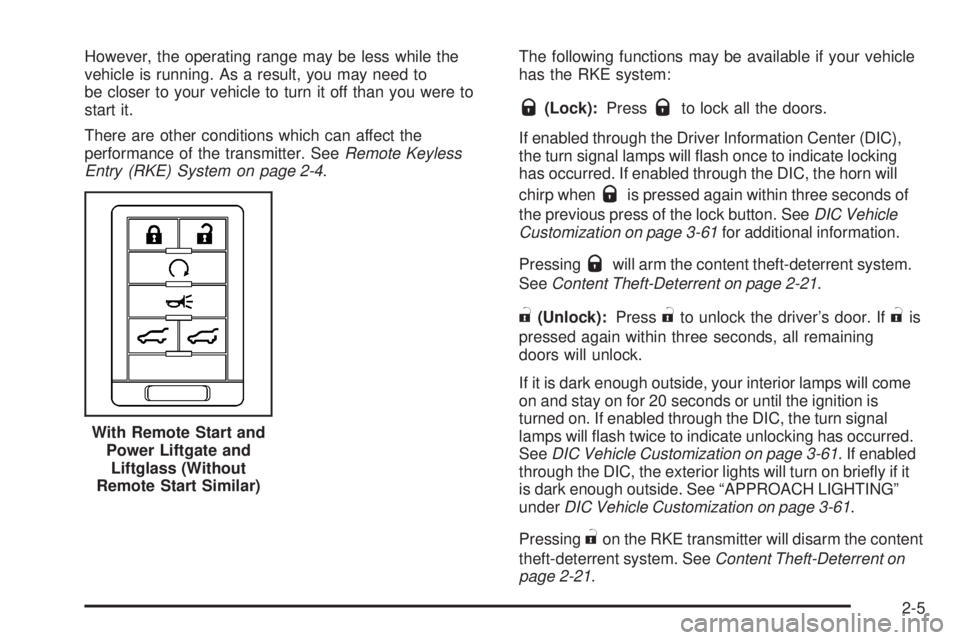
However, the operating range may be less while the
vehicle is running. As a result, you may need to
be closer to your vehicle to turn it off than you were to
start it.
There are other conditions which can affect the
performance of the transmitter. See Remote Keyless
Entry (RKE) System on page 2-4 . The following functions may be available if your vehicle
has the RKE system:
Q (Lock): Press
Q to lock all the doors.
If enabled through the Driver Information Center (DIC),
the turn signal lamps will �ash once to indicate locking
has occurred. If enabled through the DIC, the horn will
chirp when
Q is pressed again within three seconds of
the previous press of the lock button. See DIC Vehicle
Customization on page 3-61 for additional information.
Pressing
Q will arm the content theft-deterrent system.
See Content Theft-Deterrent on page 2-21 .
" (Unlock): Press
" to unlock the driver’s door. If
" is
pressed again within three seconds, all remaining
doors will unlock.
If it is dark enough outside, your interior lamps will come
on and stay on for 20 seconds or until the ignition is
turned on. If enabled through the DIC, the turn signal
lamps will �ash twice to indicate unlocking has occurred.
See DIC Vehicle Customization on page 3-61 . If enabled
through the DIC, the exterior lights will turn on brie�y if it
is dark enough outside. See “APPROACH LIGHTING”
under DIC Vehicle Customization on page 3-61 .
Pressing
" on the RKE transmitter will disarm the content
theft-deterrent system. See Content Theft-Deterrent on
page 2-21 .With Remote Start and
Power Liftgate and
Liftglass (Without
Remote Start Similar)
2-5
Page 104 of 500
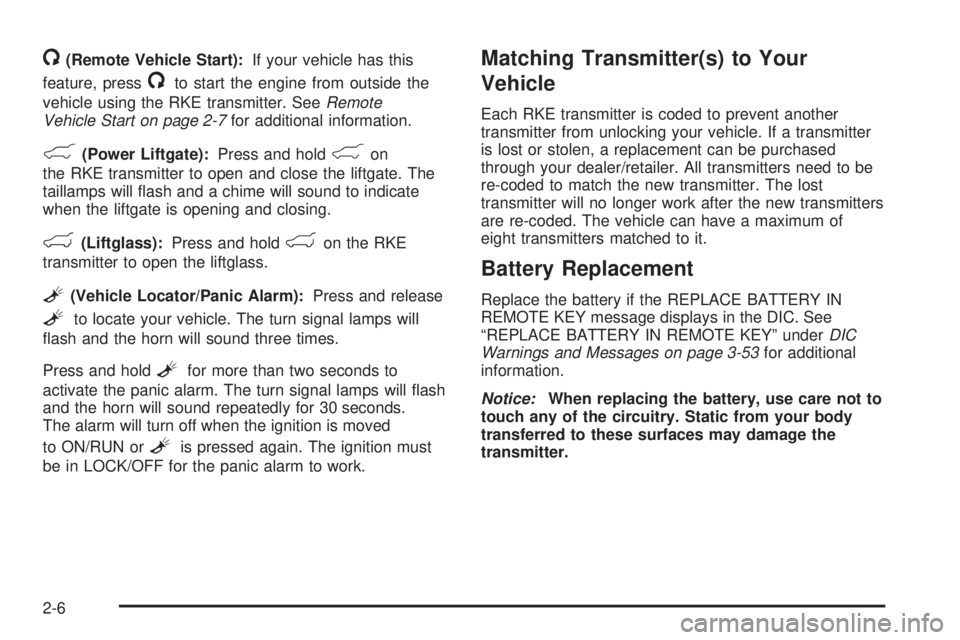
/ (Remote Vehicle Start): If your vehicle has this
feature, press
/ to start the engine from outside the
vehicle using the RKE transmitter. See Remote
Vehicle Start on page 2-7 for additional information.
& (Power Liftgate): Press and hold
& on
the RKE transmitter to open and close the liftgate. The
taillamps will �ash and a chime will sound to indicate
when the liftgate is opening and closing.
m (Liftglass): Press and hold
m on the RKE
transmitter to open the liftglass.
L (Vehicle Locator/Panic Alarm): Press and release
L to locate your vehicle. The turn signal lamps will
�ash and the horn will sound three times.
Press and hold
L for more than two seconds to
activate the panic alarm. The turn signal lamps will �ash
and the horn will sound repeatedly for 30 seconds.
The alarm will turn off when the ignition is moved
to ON/RUN or
L is pressed again. The ignition must
be in LOCK/OFF for the panic alarm to work. Matching Transmitter(s) to Your
Vehicle Each RKE transmitter is coded to prevent another
transmitter from unlocking your vehicle. If a transmitter
is lost or stolen, a replacement can be purchased
through your dealer/retailer. All transmitters need to be
re-coded to match the new transmitter. The lost
transmitter will no longer work after the new transmitters
are re-coded. The vehicle can have a maximum of
eight transmitters matched to it.
Battery Replacement Replace the battery if the REPLACE BATTERY IN
REMOTE KEY message displays in the DIC. See
“REPLACE BATTERY IN REMOTE KEY” under DIC
Warnings and Messages on page 3-53 for additional
information.
Notice: When replacing the battery, use care not to
touch any of the circuitry. Static from your body
transferred to these surfaces may damage the
transmitter.
2-6
Page 106 of 500
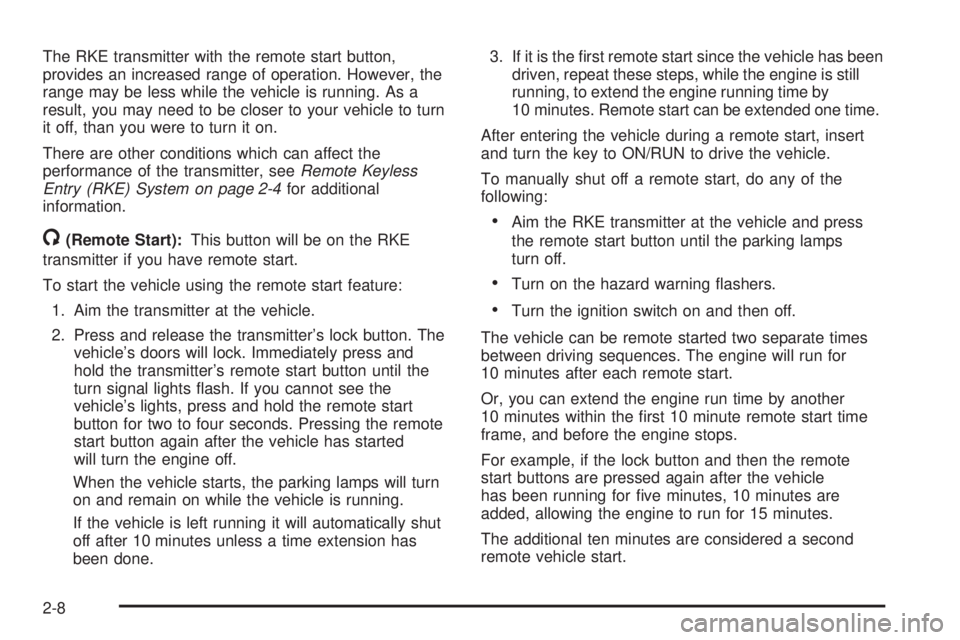
The RKE transmitter with the remote start button,
provides an increased range of operation. However, the
range may be less while the vehicle is running. As a
result, you may need to be closer to your vehicle to turn
it off, than you were to turn it on.
There are other conditions which can affect the
performance of the transmitter, see Remote Keyless
Entry (RKE) System on page 2-4 for additional
information.
/ (Remote Start): This button will be on the RKE
transmitter if you have remote start.
To start the vehicle using the remote start feature:
1. Aim the transmitter at the vehicle.
2. Press and release the transmitter’s lock button. The
vehicle’s doors will lock. Immediately press and
hold the transmitter’s remote start button until the
turn signal lights �ash. If you cannot see the
vehicle’s lights, press and hold the remote start
button for two to four seconds. Pressing the remote
start button again after the vehicle has started
will turn the engine off.
When the vehicle starts, the parking lamps will turn
on and remain on while the vehicle is running.
If the vehicle is left running it will automatically shut
off after 10 minutes unless a time extension has
been done. 3. If it is the �rst remote start since the vehicle has been
driven, repeat these steps, while the engine is still
running, to extend the engine running time by
10 minutes. Remote start can be extended one time.
After entering the vehicle during a remote start, insert
and turn the key to ON/RUN to drive the vehicle.
To manually shut off a remote start, do any of the
following:
Aim the RKE transmitter at the vehicle and press
the remote start button until the parking lamps
turn off.
Turn on the hazard warning �ashers.
Turn the ignition switch on and then off.
The vehicle can be remote started two separate times
between driving sequences. The engine will run for
10 minutes after each remote start.
Or, you can extend the engine run time by another
10 minutes within the �rst 10 minute remote start time
frame, and before the engine stops.
For example, if the lock button and then the remote
start buttons are pressed again after the vehicle
has been running for �ve minutes, 10 minutes are
added, allowing the engine to run for 15 minutes.
The additional ten minutes are considered a second
remote vehicle start.
2-8